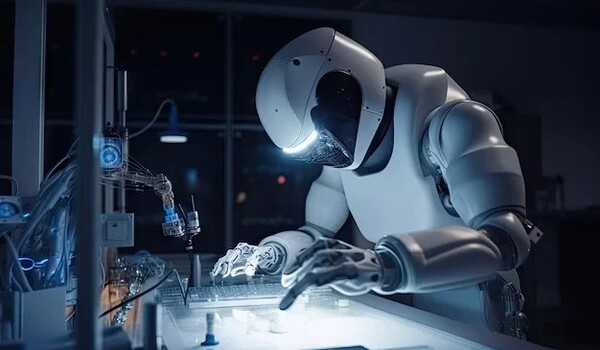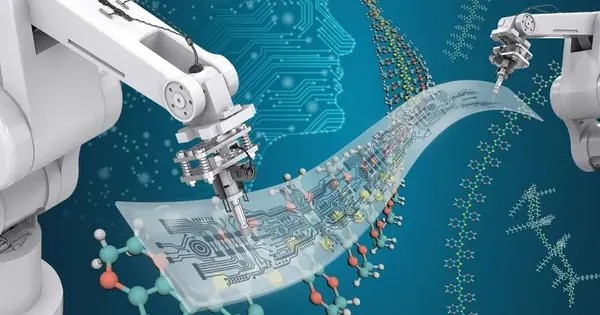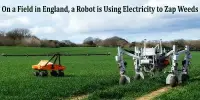Researchers from UNC Chapel Hill wrote a paper titled “Transforming Science Labs into Automated Factories of Discovery,” which was published in Science Robotics, the journal that covers robotics research. They said that science labs across disciplines, including chemistry, biochemistry, and materials science, are about to undergo a broad transformation as robotic automation and artificial intelligence (AI) lead to faster and more precise experiments that unlock breakthroughs in fields like health, energy, and electronics.
“Today, the development of new molecules, materials and chemical systems requires intensive human effort,” said Dr. Ron Alterovitz, senior author of the paper and Lawrence Grossberg Distinguished Professor in the Department of Computer Science. “Scientists must design experiments, synthesize materials, analyze results and repeat the process until desired properties are achieved.”
The pace of discovery is slowed by this labor-intensive and time-consuming trial-and-error method. Automation provides an answer. Research can be greatly accelerated by using robotic devices to do experiments constantly without human tiredness. In addition to performing exacting experiments more reliably than people, robots also lower safety hazards by handling dangerous materials. Scientists may concentrate on more complex research topics by automating repetitive operations, which opens the door to quicker advances in sustainability, energy, and medicine.
The integration of robotics and AI is poised to revolutionize science labs. By automating routine tasks and accelerating experimentation, there is great potential for creating an environment where breakthroughs occur faster, safer and more reliably than ever before.
Angelos Angelopoulos
“Robotics has the potential to turn our everyday science labs into automated ‘factories’ that accelerate discovery, but to do this, we need creative solutions to allow researchers and robots to collaborate in the same lab environment,” said Dr. James Cahoon, a co-author of the paper and chair of the Department of Chemistry. “With continued development, we expect robotics and automation will improve the speed, precision and reproducibility of experiments across diverse instruments and disciplines, generating the data that artificial intelligence systems can analyze to guide further experimentation.”
The researchers defined five levels of laboratory automation to illustrate how automation can evolve in science labs:
- Assistive Automation (A1): At this level, individual tasks, such as liquid handling, are automated while humans handle the majority of the work.
- Partial Automation (A2): Robots perform multiple sequential steps, with humans responsible for setup and supervision.
- Conditional Automation (A3): Robots manage entire experimental processes, though human intervention is required when unexpected events arise.
- High Automation (A4): Robots execute experiments independently, setting up equipment and reacting to unusual conditions autonomously.
- Full Automation (A5): At this final stage, robots and AI systems operate with complete autonomy, including self-maintenance and safety management.

The researchers’ established levels of automation can be used to gauge advancements in the field, assist in developing suitable safety procedures, and identify objectives for further research in robotics and science fields. Even though lower levels of automation are typical now, reaching high and complete automation is a research problem that will call for robots that can function in a variety of lab settings, manage challenging jobs, and communicate with humans and other automation systems in a smooth manner.
Automation is progressing beyond physical activities thanks in large part to artificial intelligence. Large experimental datasets can be analyzed by AI, which can also spot trends and recommend novel substances or lines of inquiry. By incorporating AI into the workflow, labs will be able to automate every step of the research process, from creating tests to creating materials and evaluating the outcomes.
The conventional Design-Make-Test-Analyze (DMTA) cycle can become completely autonomous in AI-driven labs. AI might choose which trials to carry out, make corrections in real time, and enhance the study process over time. Even while AI systems have demonstrated early success in tasks like chemical reaction prediction and synthesis route optimization, the researchers warn that AI needs to be closely watched to prevent concerns like the unintentional production of hazardous compounds.
Making the switch to automated labs is fraught with logistical and technical difficulties. The configurations of laboratories vary greatly, from enormous, multiroom facilities to single-process labs. Mobile robots that can move objects and carry out duties across several stations will be necessary to develop adaptable automation systems that function in a variety of settings.
It is equally necessary to train scientists to work with sophisticated automation systems. To speed up their research, scientists will need to become experts in their disciplines as well as comprehend the potential of robots, data science, and artificial intelligence. To fully utilize automated laboratories, the next generation of scientists must be trained to work in tandem with engineers and computer scientists.
“The integration of robotics and AI is poised to revolutionize science labs,” said Angelos Angelopoulos, a co-author of the paper and research assistant in Dr. Alterovitz’s Computational Robotics Group. “By automating routine tasks and accelerating experimentation, there is great potential for creating an environment where breakthroughs occur faster, safer and more reliably than ever before.”
















